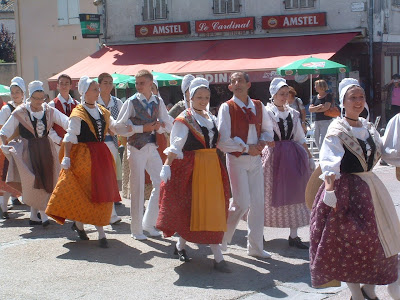
Every August our local market town sees an invasion. It has been going on for over 50 years, fortunately for the townspeople, the invaders are friendly. They arrive in coaches, rather than tanks, and they fill the streets with colour and a wide variety of languages.
It's the annual folklore festival of music and dance, and it happens in many a French town during the summer.
<

It began for Montrejeau in 1959, and many of the countries taking part came from parts of Europe that were still firmly behind the Iron Curtain. I suppose it was one way of getting out and seeing what was going on in the rest of Europe - cultural visits being allowed, but I wonder if all the dance groups went home with as many as they came with?

Today's dancers and musicians come from all over the world as well as Europe. Most of the African or Caribbean performers come from former French colonies, and they certainly give the town an exotic air for a day or two. South America gets in on the act too, I remember one year a large Puerto Rican group brought traffic to a standstill, and almost took the whole show over in their wild enthusiasm.


One year, to our amazement, we heard what sounded like a Scots pipe band coming into the square... and it was. They went down a storm. Last year there were some Morris Men from Plymouth complete with fool ... they were greeted with bewilderment. Pipes, the French can do, a lot of French departments have a history of bagpipes... in fact the Breton group that came a couple of years ago had 'baguettes' that were almost identical to the Scots variety. Not so sure about their understanding of men with flowers in their hats and bells on their legs, waving coloured ribbons in the air.

It's nice to know that this wonderful cultural exchange is still going on after 50 years, and with no sign of the enthusiasm waning, certainly not on the part of the performers. On the last day they are here it's market day, and with summer tourists,plus 400 dancers, musicians and back-up teams (mostly still in national dress) the town is absolutely jammed packed. When it co-incides with a public holiday(The Feast of the Assumption)it's even worse. Thank goodness it's a good-will invasion.







